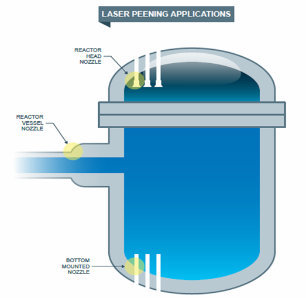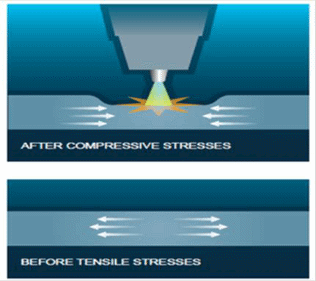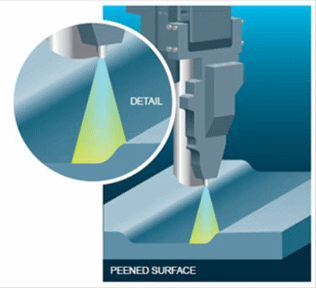Background
Stress corrosion cracking (SCC) of nuclear steam supply systems poses a significant problem for the nuclear industry. SCC occurs when the following three factors are present:
- Susceptible material
- Corrosive environment
- Tensile stress
Eliminating any one of these factors mitigates SCC. Laser peening converts tensile stress into compressive stress to arrest existing SCC and eliminates the potential for SCC to develop. Laser peening is a carefully controlled process that mechanically compresses the surface using laser energy and water, which controls and mitigates future SCC.
There are three primary locations for SCC: reactor vessel head penetrations (RVHP), reactor vessel nozzles (RVN) and bottom-mounted instrumentation (BMI) nozzles.
Description
The patented laser peening approach was developed in the early 1990s by Toshiba using water as a medium to capture the peening energy.
This approach focuses a laser pulse on the surface to create a plasma layer. Because plasma expansion is prevented in water, the laser energy becomes locally concentrated on the metal surface generating shock waves that impact the surface with a force of several gigapascals. The shock wave transmits into the metal but is hampered by surrounding parts. This controls the amount of deformation occurring in the metal, forcing the tensile stress, which stretches the metal, to be converted into compressive stress, which compresses the metal.
All of this is done without the need for dangerous high-pressure water and the equipment and hoses to support it.
Benefits
Laser peening is a permanent solution that mitigates SCC for the duration of plant operation in both pressurized and boiling water reactors. The permanence of this solution is important to an effective asset management program. Laser peening both prevents SCC initiation and arrests growth of existing SCC.
Laser peening will ultimately reduce plant operating costs through emergent issue prevention. A return on investment can be realized through the cost avoidance of less than two emergent or unplanned weld repairs. Inspection relief can also be sought following successful application.
Experience
Toshiba performed the first laser peening in the nuclear industry in 1999. There has been no initiation of SCCs in the more than 509 pressurized water reactor and boiling water reactor applications the company has performed worldwide since then.




